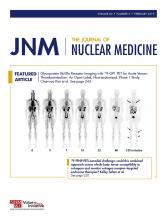TO THE EDITOR: Although the joint Society of Nuclear Medicine and Molecular Imaging (SNMMI) and the American Society of Nuclear Cardiology (ASNC) expert consensus (1) document has provided a comprehensive review on the role of 18F-FDG PET/CT in cardiac sarcoid (CS) detection and therapy monitoring, we would like to highlight a few additional points that would warrant the authors’ consideration.
Regarding patient preparation for the CS 18F-FDG PET/CT, the expert panel recommended the preferred option being for the patient to consume at least 2 high-fat (>35 g), low-carbohydrate (<3 g) meals the day before the study and then fast for at least 4–12 h. We adopted a 72-h high-fat, high-protein, very-low-carbohydrate (HFHPVLC) diet preparation, with satisfying results (2). Our study included 215 18F-FDG PET/CT tests from 207 patients with biopsy-proven sarcoidosis and clinical suspicion for CS between July 2014 and December 2015, the largest patient cohort to undergo CS 18F-FDG PET/CT so far. On the basis of diet preparation protocol, we categorized the patients into 2 groups. Group 1 patients had a 24-h or less pre–18F-FDG PET/CT HFHPVLC diet, whereas group 2 patients had a 72-h HFHPVLC diet before 18F-FDG PET/CT. All patients had a HFHPVLC breakfast 4 h before scheduled 18F-FDG PET/CT. We found that the 72-h HFHPVLC diet protocol achieved complete suppression of physiologic myocardial 18F-FDG uptake in 86.7% (167/193) of patients, with only 3.6% (7/193) of patients with failed suppression and indeterminate for CS. In contrast, only 50% (6/12) of patients in group 1 had complete suppression of myocardial 18F-FDG uptake and were negative for CS, and 41.7% of patients (5/12) had failed suppression and indeterminate for CS. The high incidence of failed suppression in the 24-h HFHPVLC diet protocol is in keeping with the authors’ statement that “nonspecific myocardial uptake may be observed in up to 20% of patients despite various dietary preparations.” Because our data showed that the 72-h HFHPVLC diet protocol surpassed the 24-h diet preparation approach, with high patient compliance and physician stratifications, we would recommend and encourage the authors and other investigators to verify this simple and straightforward protocol in their practices.
As for interpretation for cardiac PET, the authors prefer to have both rest myocardial perfusion study and cardiac 18F-FDG PET. We agree that a concurrent rest myocardial perfusion study can somewhat increase diagnosis confidence in CS (3). However, decreased perfusion at rest is not specific nor sensitive for CS diagnosis; many CS can have normal or even increased perfusion. Our experience also showed that, with optimal suppression of physiologic myocardial 18F-FDG uptake, the rest myocardial perfusion study or reorientation/reconstruction of cardiac 18F-FDG PET/CT images might not be needed (4,5). The authors recommended interpretation of concurrent myocardial perfusion and 18F-FDG PET images mainly based on the data from Brigham and Women’s Hospital, which included 118 patients over a 5-y period who underwent <24-h HFHPVLC diet followed by a fast of at least 3 h before 18F-FDG PET and 82Rb myocardial perfusion PET (6). As we commented about their data before (2), the diffuse myocardial 18F-FDG uptake that was defined as normal perfusion was probably due to failed suppression, thus indeterminate for CS. The focal on diffuse pattern of myocardial 18F-FDG uptake, which was interpreted by the Brigham and Women’s Hospital group as areas of inability to suppress 18F-FDG from normal myocardium versus diffuse inflammation, was instead categorized into abnormal metabolism and PET-positive. This description actually reflected the nature of indeterminate for CS in this focal on diffuse pattern. We think the focal increased tracer uptake in the focal on diffuse pattern is mainly due to physiologic papillary muscular uptake, rather than CS. Thus the focal on diffuse pattern is probably due to suboptimal suppression and should be counted as diffuse and nondiagnostic for CS. In our study (2), all the patients underwent the same 18F-FDG PET/CT imaging protocol on the same scanner with a time span of 1.5 y. We classified cardiac 18F-FDG uptake as none and ring-like diffuse at base (negative for CS); focal (positive for CS); and diffuse (indeterminate for CS). We found that this classification renders CS 18F-FDG PET/CT interpretation very straightforward and easy to follow, with high interobserver agreement among senior radiology residents and radiology and nuclear medicine attending physicians. In our study, all the positive CS had concordant cardiac MRI findings wherever MRI was available, and both positive and negative CS had consistent results on available follow-up 18F-FDG PET/CT scans. Furthermore, the indeterminate rate (including both focal on diffuse and diffuse patterns) is very low in the 72-h HFHPVLC diet group. On a different note, we want to echo the authors’ opinion that, given the high incidence of coexisting thoracic and extrathoracic sarcoidosis, the field of view of 18F-FDG PET/CT should be from the skull base to thigh, or at least include both chest and abdominal organs to better evaluate the extent of sarcoidosis disease (7).
We appreciate the joint SNMMI–ASNC expert panel’s comprehensive review. Nonetheless, imaging of CS remains challenging. Long-term prospective multicenter clinical trials are required to further validate the optimal PET imaging protocol.
Footnotes
Published online Nov. 9, 2018.
- © 2019 by the Society of Nuclear Medicine and Molecular Imaging.







